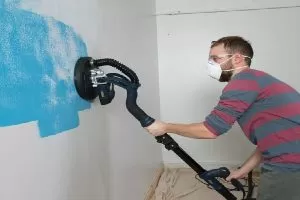The Art of Wall Sanding
Sanding is easy, but it is important to know some aspects to consider to have better results. We will teach you how to use different sanding equipment and the best way to do it. Sanding is done to prepare the walls to be painted.
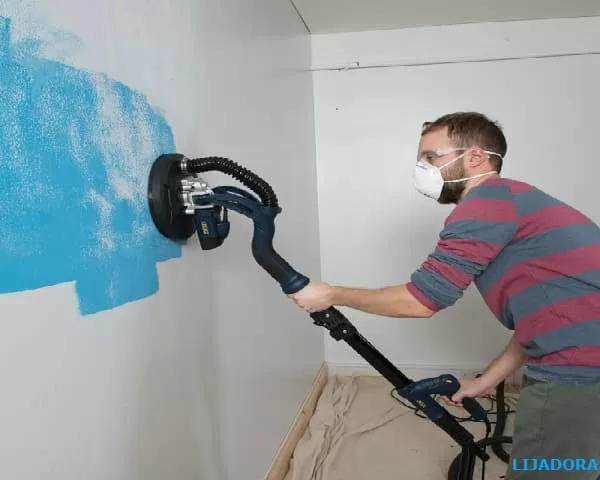 Here We Have Certain Points That You Must Take Into Account to Know How to Sand Walls
Here We Have Certain Points That You Must Take Into Account to Know How to Sand Walls
- A good idea is to completely remove the furniture in the room, if possible.
- Remember to wear safety glasses and wear appropriate work clothes because of the dust generated.
- Dust and clean the walls. For most surfaces, use a towel or vacuum cleaner.
- When painting a bathroom or kitchen, wash the walls with a solution of approximately three teaspoons of laundry detergent in a gallon of water.
- Scrape any cracked or peeling paint with a paint scraper.
- For other small imperfections in the wall, such as plaster bumps, smooth them with sandpaper. Use muscle strength with a piece of water sandpaper stapled to a sanding block, or use an electric sander.
How to Sand Walls Fast ?
Sanding the walls is a task that many times is not very fast to execute, to do it quickly it is very important to have on hand tools such as electric sanders, in order to reduce the amount of time you will need to do it manually.
You should remember to place plastics and newspapers to cover things you don’t want to be filled with dust.
How to Sand Walls to Paint ?
If you cannot move the furniture in a room, move them to the center of the room and cover them with plastic fabrics glued with adhesive tape on the bottom This will not only protect your furniture from paint drops and splashes, but also remove all dust of sanding.
The best way to prepare the walls begins with sanding and sometimes requires scraping. Sanding wears away the existing surface so that the paint grips; Scraping will remove any potholes or old drips.
Sand the walls from the baseboard to the ceiling with fine-grained sandpaper or a bar sander. Next, sand horizontally along the baseboard and the roof.
Do not put too much pressure on the bar sander or the head may turn over and damage the wall. Sand the wood with a sanding sponge to get cracks.
You should also take your time patching holes, masking gaps and cleaning dust or grease with soap and water to start with a pristine surface.
How to Sand Painted Walls ?
Wash the wall to remove grease.
Fill the holes and cracks with a suitable filling, perhaps using a flexible filling for cracks.
Sand and scrape the full areas: sanding will seal the filling and keep it in place. You may want to sand and reapply the entire wall to avoid an irregular appearance.
How to Sand Plaster Walls ?
Plaster is a material that covers the wall and ceiling. It can be smooth, rough or textured. To paint a plaster wall, you’ll want to sand to the bare plaster to achieve the most effective and durable paint application.
To sand a plaster wall, you should use coarse sandpaper on the rough textured wall and finer grain sandpaper on smooth surfaces.
It is important that you take your time to sand the plaster, as it can crack or damage the wall if you sand too hard. Sanding plaster is not difficult, but it is complicated and takes a long time.
How to Sand Cement or Concrete Walls ?
Clean the wall with the spatula or brush with metal spikes. This will allow you to remove any extra cement or dirt.
Place a diamond sandpaper to a manual grinder. A diamond sandpaper is the only type strong enough to sand through the top layer of cement or concrete.
Press the grinder against the wall and start applying firm pressure. After a few minutes, the concrete will begin to have a slight shine, it is necessary to remove only a small part of the top layer of the cement.
Continue sanding until you get the shine you want. Wipe the walls with a damp towel to remove sanding dust.
How to Sand Dripping Paint ?
What is Drip ?
It is a special type of plaster that is sprayed directly on a wall or ceiling, which gives it a mottled or dotted tempera effect that is currently out of fashion.
Before starting to remove the gotelé, it is important to know the finish that the wall has.
This finish can be done with paint. To find out, you must wet the wall with a little water and see if the water is absorbed or not.
In the case of being absorbed, the paint used for the gotelé is tempered and, otherwise, is plastic paint.
If it is tempered, the best way to remove the gotelé is to use a special product for it.
Thanks to this product, the wall paint softens in a very easy way and with the help of a spatula the gotelé can be removed without problems
What is the Sandpaper Used to Sand Walls ?
Sandpaper comes in different shapes and sizes:
- Sheet: usually 9 by 11 inches (23 by 28 cm), but other sizes may be available
- Belt: usually with fabric backing, it comes in different sizes to fit different belt sanders.
- Disk: made to fit different disk models and random orbit sanders. It can be drilled for some models of sanders. The accessory includes pressure sensitive adhesive (PSA) and “hook and loop” (similar to Velcro).
- Rolls: known as “lint rolls” by many contractors.
- Sponge: for narrow places.
The abrasive particles of sandpaper are known as grain or grain, with the number of abrasive particles per inch that determine the roughness of the sandpaper, from coarse to fine.
Coarse sandpaper has low numbers, between 40 and 60, while fine sandpaper has higher numbers, from 150 onwards.
The sand you choose depends on the task at hand. Thicker sands, for example, are better for heavier jobs, such as peeling and sanding; finer grains are intended for finishing work
To achieve a good sanding of the furniture surface or what we are going to sand, it is advisable to increase the numbering little by little.
Types of Abrasives
There are five main types of sandpaper available
- Glass paper, also known as flint paper, is very light, usually pale yellow.
- Garnet paper is generally a brownish red color, which is commonly used in carpentry. Garnet is an excellent option for final sanding.
- Aluminum oxide: It is the type of paper most used in electric sanders. Aluminum oxide is more durable than garnet paper, but does not leave such a pleasant finish.
- Silicon carbide paper is usually dark gray or even black. This type of paper is mainly used for metal finishing or for “wet sanding”, using water as a lubricant. While some advanced finishes use silicon carbide paper.
What are the Machines or Tools for Sanding Walls ?
Belt Sander
Use a continuous loop of sandpaper stretched on rollers Best for sanding rougher stocks Quickly removes large materials Available in various sizes and speeds.
Disc Sander
It combines both a sanding belt and a disc. It works with a powerful motor. Typically, a large and heavy sander Oscillating shaft sander Dual-purpose sharp sander protruding from a base.
The oscillating shaft moves up and down and in a circular motion, uses an abrasive sleeve to sand Random Orbital Sander.
The sanding disc moves in a random orbital movement. It uses a hitch system to facilitate paper change, Compact and lightweight, one of the most affordable and highly versatile types.
It has a square pad. It moves in small circular orbits.
Orbital Sander
Use small square papers that come in various sizes, use spring clips to hold the papers in place.
Drum Sander
Large and versatile sander. It has a single drum with open or closed ends and there are also some double drum units.
Detail Sander
Similar to the random orbital sander but with a triangular shaped base.
Interchangeable sanding pads.
Compact and light but noisy.
How to Sand Walls With The Electric Sander ?
Electric sanders are the best, fastest and easiest to sand. In short, they are the best way to make an unbearable task a little more enjoyable.
There are several sizes and types of sanders available there are three types: belt sanders, orbital sanders and random orbit sanders.
With these three portable power tools, and the right abrasive, you can sand virtually any surface or edge you may find.
How to Sand Walls With Orbital Sander ?
The orbital sander is the oldest, simplest and least expensive of these two tools. It usually has a square foot that accepts a quarter of a sheet of 9 × 11 sandpaper.
As a result, these tools are often called quarter sheet sanders. (There are also half-blade orbital sanders).
To create the sanding action, the sander’s foot vibrates rapidly in small circles or orbits.
Advantage
- The best feature of the orbital sander is its square shape, which allows it to be placed at the corners and against the edges.
- You can also use a regular cut of sandpaper to adapt it instead of custom-made random orbit sanding discs.
- Orbital sanders are not too aggressive, so it is difficult to remove too much material.
- Compared to hand sanding through the grain or with a belt sander, they leave less obvious cross grain marks, which means that it is more difficult to ruin your work.
- The performance and scratch pattern differ from one brand to another, so be sure to test the sanding pattern before assuming yours will not leave visible cross scratches.
Disadvantages
- The main disadvantage is that sanding marks are usually more visible compared to a random orbit sander. Another drawback is that they do not remove a large amount of material.
- And although some designs are better than others, the clamps that hold the sandpaper in place are less convenient than the in-place pressure options used for random orbit sanders.
The Best Uses
Orbital sanders are useful for places where a random orbit sander would not fit, and when only light sanding is required. They are perfect for preparing a surface to paint or seal, or to tear down a coat of paint.
They are also useful when you are painting a wooden floor again and you need to take the baseboards to the corner.
Sanding Walls with Manual Sander
There are two different types of hand sander available: a hand sander and a bar sander. A hand sander is a hand tool used to sand rough materials and uneven surfaces, such as walls, floors and other large flat areas.
Its body consists of an ergonomically designed handle attached to a sander head, a pair of clamps and a base that supports sandpaper.
It is similar to a manual sander in many ways, apart from its handle. Instead of a rounded handle, it has a long stick for the user to grip, so that the sander reaches difficult places. A bar sander is often used on walls, ceilings and floors, since its design means that it can accelerate the task of sanding large areas.
How to Sand Walls With Eccentric Sander ?
It is a tool designed primarily for fine sanding and finishing of surfaces and materials such as wood, metal, glass and plastics.
It usually comes with a round sanding pad that is off center on the drive shaft and can rotate freely or with a restricted guide parallel to the surface.
With a restricted guide, the extraction rate increases substantially and can be sanded enough.
With integrated dust extraction, adjustable electronic control and optional soft start, the random or eccentric orbit sander has many potential applications.
How to Sand Walls with Giraffe Sander ?
- It is designed to make sanding and cleaning inside and outside simply faster, easier, cleaner and perfect.
- With the long giraffe neck you can reach ceilings up to 3 meters high without stairs or scaffolding.
- The exclusive two-position sanding head facilitates sanding the ceiling and creates a finer finish.
- This machine is ideal for sanding drywall, cement panels, styrene insulation panels, paint preparation and coatings.
How to Sand Walls With Grinder ?
An angle grinder is an incredibly versatile tool. It can be used to cut, grind, peel or finish surfaces.
Not only this, but it can be used in a variety of materials, from wood and masonry to concrete, tiles, bricks, asphalt and metal.
What makes the grinder so versatile is the variety of discs and accessories that can be used with it. However, its versatility can tempt people to use the nearest disk, regardless of the application.
To be safe and efficient, it is very important to choose the right accessory for the job.
Wire discs and cup brushes are designed to remove paint, peel, polish and remove metal burrs from cutting metal.
Metal cutting discs cut sheet steel and all types and profiles of steel within the capacity of the blade diameter
Grinding discs are ideal for grinding metal, stainless steel and masonry, as well as for sharpening tools and finishing welding joints.
The fin discs are ideal for the most efficient disposal of waste material in wood and steel. They are particularly good for cleaning steel, removing burrs, cleaning welding areas and removing paint and rust. Diamond cutting saws are excellent for cutting masonry, tiles, stone, granite and concrete.
How to Sand Walls With Drill ?
Flat sanding papers and sanding blocks are ideal for flat surfaces, but when you need to sand curves and arcs, you need a curved sanding surface.
Use your cordless drill and sanding drum to obtain a smooth surface even in the most irregular shapes.
Related Topics in ALPHAPEDIA
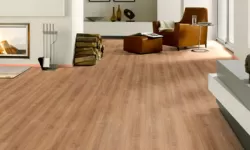
How to INSTALL LAMINATE FLOORING ?
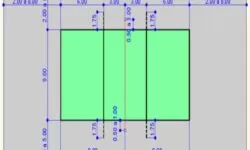
💚 VOLLEYBALL COURT DIMENSIONS

💚 WHAT IS ELECTRICITY FOR ?

💚 WHAT IS NEUTRAL IN ELECTRICITY ?

💚 WHAT IS PHASE IN ELECTRICITY ?

💚 WHAT IS STATIC ELECTRICITY ?
Sander Tools in ALPHAPEDIA

ACCESSORIES FOR Orbital and Drill SANDING MACHINES
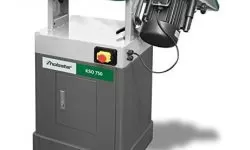
BELT SANDER: Great Price on Qualified Products
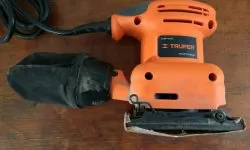
ORBITAL TRUPER SANDER: Great Price on Qualified Products
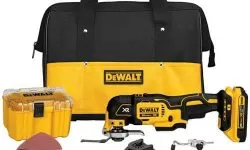
DEWALT ORBITAL SANDER: Great Price on Qualified Products

💚 WALL SANDER: ¿ How to Use It ? Brands and Models
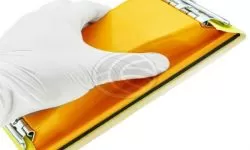
MANUAL HAND SANDER: Brands as Dewalt and Black & Decker
Other Topics of Interest in ALPHAPEDIA

FREE CERTIFICATE PROGRAM IN ART HISTORY

FREE BACHELOR DEGREE IN BUSINESS RELATIONS

FREE MASTER DEGREE IN PROJECT EVALUATION

FREE BACHELOR DEGREE IN SECRETARIAL SCIENCE

FREE ADOBE ILLUSTRATOR COURSE

UNIVERSITY OF THE UNITED STATES: Privates and Publics
Image of How to Sand Walls
